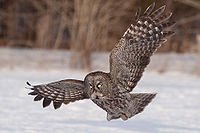Great Grey Owl
 From Conservapedia
From Conservapedia | Great Grey Owl | |
|---|---|

| |
| Scientific classification | |
| Kingdom Information | |
| Domain | Eukaryota |
| Kingdom | Animalia |
| Subkingdom | Bilateria |
| Branch | Deuterostomia |
| Phylum Information | |
| Phylum | Chordata |
| Sub-phylum | Vertebrata |
| Infraphylum | Gnathostomata |
| Class Information | |
| Superclass | Tetrapoda |
| Class | Aves |
| Sub-class | Neornithes |
| Infra-class | Neoaves |
| Order Information | |
| Order | Strigiformes |
| Family Information | |
| Family | Strigidae |
| Sub-family | Striginae |
| Genus Information | |
| Genus | Strix |
| Species Information | |
| Species | S. nebulosa |
| Population statistics | |
| Population | 190,000+ est. (2015) |
| Conservation status | Least concern[1] |
Contents
Subspecies[edit]
- Strix nebulosa lapponica; Eurasia
- Strix nebulosa nebulosa; North America
Range[edit]
The great grey owl is found primarily in the boreal conifer forests of the Northern Hemisphere, occupying a latitudinal band from the Scandinavian Peninsula eastward into much of Russia; in North America it is found in Alaska eastward through to Ontario. The southern limits in the western United States are defined by montane and subalpine forests in the states of Montana, Wyoming, Idaho, Washington, Oregon, Nevada and California. The northern range of the owl is limited to the treeline/tundra boundary near the Arctic Circle.
Threats[edit]
Grey owls are sometimes preyed upon by the larger horned and eagle owls of the genus Bubo, as well as by other raptors such as hawks and eagles. Man also plays a role: timber harvesting degrades habitat, in addition to recreational activities disturbing the owls, such as camping and hiking. Poison traps meant for rodent pests have inadvertently killed many owls, as well as overhead wires and large wind turbines.[2]
References[edit]
Categories: [Birds] [Birds of Prey] [Owls] [Wood Owls]
↧ Download as ZWI file | Last modified: 02/10/2023 23:16:42 | 2 views
☰ Source: https://www.conservapedia.com/Great_grey_owl | License: CC BY-SA 3.0
 ZWI signed:
ZWI signed: KSF
KSF